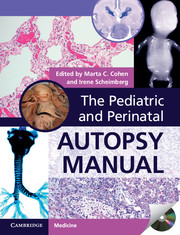Book contents
- Frontmatter
- Contents
- List of contributors
- Foreword
- Preface
- Acknowledgments
- 1 Perinatal autopsy, techniques, and classifications
- 2 Placental examination
- 3 The fetus less than 15 weeks gestation
- 4 Stillbirth and intrauterine growth restriction
- 5 Hydrops fetalis
- 6 Pathology of twinning and higher multiple pregnancy
- 7 Is this a syndrome? Patterns in genetic conditions
- 8 The metabolic disease autopsy
- 9 The abnormal heart
- 10 Central nervous system
- 11 Significant congenital abnormalities of the respiratory, digestive, and renal systems
- 12 Skeletal dysplasias
- 13 Congenital tumors
- 14 Complications of prematurity
- 15 Intrapartum and neonatal death
- 16 Sudden unexpected death in infancy
- 17 Infections and malnutrition
- 18 Role of MRI and radiology in post mortems
- 19 The forensic post mortem
- 20 Appendix tables
- Index
- References
11 - Significant congenital abnormalities of the respiratory, digestive, and renal systems
Published online by Cambridge University Press: 05 September 2014
- Frontmatter
- Contents
- List of contributors
- Foreword
- Preface
- Acknowledgments
- 1 Perinatal autopsy, techniques, and classifications
- 2 Placental examination
- 3 The fetus less than 15 weeks gestation
- 4 Stillbirth and intrauterine growth restriction
- 5 Hydrops fetalis
- 6 Pathology of twinning and higher multiple pregnancy
- 7 Is this a syndrome? Patterns in genetic conditions
- 8 The metabolic disease autopsy
- 9 The abnormal heart
- 10 Central nervous system
- 11 Significant congenital abnormalities of the respiratory, digestive, and renal systems
- 12 Skeletal dysplasias
- 13 Congenital tumors
- 14 Complications of prematurity
- 15 Intrapartum and neonatal death
- 16 Sudden unexpected death in infancy
- 17 Infections and malnutrition
- 18 Role of MRI and radiology in post mortems
- 19 The forensic post mortem
- 20 Appendix tables
- Index
- References
Summary
Introduction
This chapter deals with congenital abnormalities that affect the respiratory, digestive, and renal systems, with only brief reference to genetic/epigenetic mechanisms, embryologic interpretation, and the pathophysiological consequences that stem from their deranged development. To catalog all possible abnormalities would be beyond the scope of this introductory section. Acknowledging that authoritative texts on prenatal diagnoses and perinatal pathology have been published, we have tailored our discussion to serve as a beginner’s guide on the how-to and what-to observe while performing a perinatal autopsy.
Respiratory system anomalies
Gas exchange in the fetus occurs in the placenta. The lungs inflate and become functional at birth. To assume this vital transition, the structural and functional integrity of the thorax, diaphragm, airways, alveolar epithelium, as well as hemodynamic adjustments in the lesser circuit, and appropriate modulation of the autonomic nervous, endocrine, and immune systems, must harmonize. Lung maldevelopment and immaturity are major causes of neonatal mortality.
Although developmental lung abnormalities can be detected by prenatal ultrasound, post mortem examination is the gold standard to validate and document anomalies of the respiratory tract. Familiarity with the clinical presentation, perinatal anatomy and methodic observation are indispensable to disclose abnormalities, especially of those unsuspected prior to birth. Confirmation of the patency and integrity of the epiglottis, larynx, trachea, bronchi, their relationship with vascular structures, and evaluation of interventional devices and procedures should be undertaken before elaborate dissection, preferably while the organs are in situ.
- Type
- Chapter
- Information
- The Pediatric and Perinatal Autopsy Manual , pp. 205 - 234Publisher: Cambridge University PressPrint publication year: 2000

